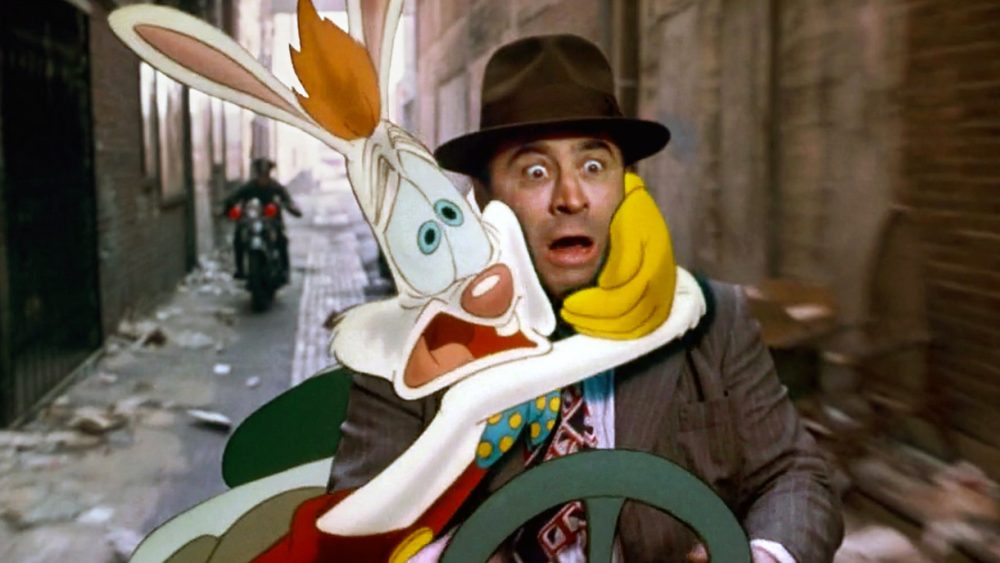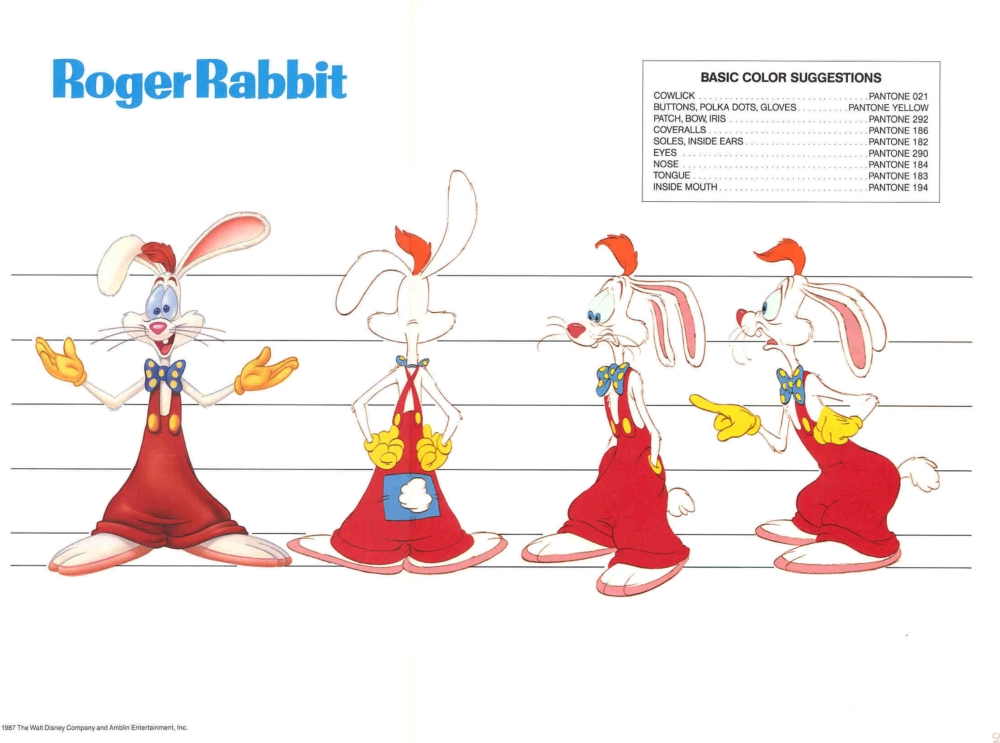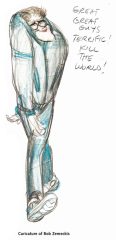“[Robert Zemeckis] asked, ‘But isn’t it more work?’ And I replied, ‘What do you think animation is? It’s nothing but work. That’s our job, turning things in space.’”
— Richard Williams
My next huge opportunity came in 1986 with Who Framed Roger Rabbit. Disney had developed the project for seven years and Robert Zemeckis worked on it when he was younger. Then he said, “I’ll see you guys later,” and left.
At that time Bugs Bunny was the top animation character in the world so why, for a start, would they try and do a grey rabbit? So the thing languished. Then Zemeckis did Back to the Future, which was very big. He was a protégé of Steven Spielberg and wanted to get the rights from Disney, so they — Spielberg and Disney — had made a temporary marriage and were looking for an animation director. But I didn’t want to do it.
I said to Zemeckis, “I love the early Disney movies — Snow White, Dumbo, Bambi, Pinocchio, Fantasia. But I thought the animation in Mary Poppins was awful. The cartoons look pasted on. They look like they’re on a piece of glass in front of the characters. You’re mixing the two realms and they don’t fit. It demeans the animation and it also wrecks the live action. This pasted-on business is just no good.”

Penguins and Eyelines
He replied, “But have you seen Star Wars: Return of the Jedi, with the motorbikes flying through the forest?’
He said, “Industrial Light & Magic has figured out a way of printing the cartoon thing, the drawn thing, so that it fits into the live action. They expose it differently, so you’ve got the different levels working.” And I said, “Well, then we can do it.” And then Zemeckis replied, “In Mary Poppins, the penguins are actually animated beautifully because they got the eyelines right.”
So when Bob Hoskins is looking at the animated characters in Who Framed Roger Rabbit, you believe he is interacting with them. He had this wonderful ability to stop his eyes right at the belt line which was at the level with the Rabbit’s eyeline. I asked him, “How did you get that concentration?” He said, “Don’t make me think about it or I won’t be able to do it.”
Zemeckis said that the animation directors always insisted on having a locked-off camera, so the camera was still, which meant that the animators didn’t have to turn the characters much. He told me, “I’m trying to shoot a modern movie where the camera’s moving all the time,” and I said, “That’s no problem.” He said, “But all the animation directors we’ve talked to say you have to have it locked off.” And I said, “Because they’re lazy bastards.”
He asked, “But isn’t it more work?” And I replied, “What do you think animation is? It’s nothing but work. That’s our job, turning things in space.”

It was a very expensive technique, this kind of moving camera technique, because it meant that we had to print every frame of the film that we were going to animate. They would print it at Industrial Light & Magic in San Francisco, mail it over to us and we’d have these big drawings, big pictures for each frame — you’d just put a piece of paper on it, and draw a rabbit in there.
Animation is time-consuming, but that was really time-consuming — that’s why there were so many people on it. After every hand-drawn film, they store all the drawings, and with Roger Rabbit they had about three times as many as normal.
It wasn’t 3D, more like 2-and-a-half D. The animation worked because the characters weren’t quite round. We back-lit, with a sort of rim light, and I’d have to draw them on. It was quite a simple thing, as I figured out. Because a lot of the live action was blurred, the images were blurred naturally. At 24 frames a second, it was just going to be a blur. So they said, “You can’t put a hard-edged piece of animation into that,” and I said, “Well I already have — strangely enough, on a commercial I animated for Disney, with all the Disney characters playing football” — and I’d broken all the rules.
I said, “I can prove it, let’s give it a try.” So we did a test sequence — a sort of obstacle course the Rabbit would have to deal with — in the live-action world. We filmed an actor in a back alley with beer cans and neon lights flashing and I drew the Rabbit coming down the stairs and he lit up as a car went past, then bashed into a bunch of garbage cans at the bottom. All we did was just put a string on the garbage cans, pulled them away, and it looked as though the Rabbit had knocked them over. And then a marvelous guy called Ken Ralston at Industrial Light & Magic did all the effects and it worked. The two realms came together.
Michael Eisner, who headed Disney then, was very dubious about the thing. So he took the test — it was about a minute and a half — home to his private screening room and invited the neighborhood kids in and ran it and said, “Do you think I should invest in this?” And all the kids said, “Yeah, yeah, yeah!” And that’s how they made Roger Rabbit.
Rabbit in the Fridge

My favorite part of the film is the opening. Bob Zemeckis used to come in and say, “You’re not still working on that opening are you?” And I’d say, “Well.” And he’d say, “Well, just do a good solid Tom and Jerry, just do it like that. Don’t make a big deal of it.” Of course, I realized that this was the part of the film that was being left to me, so I started working at night on it, and Bob came in at one point and said, “Oh God, Dick, you’re not still working on that opening? You know, if they catch you doing it, they’ll fire you.” Translation: I’ll fire you. But I’d done so much of it that it went through, and I was very pleased. I knew it was going to work. I did the transition to the live action with the Rabbit in the fridge and the baby throwing his fit and he gooses the girl and so on. Although I was directing the animation of the entire film, that was the end of my own animation — it was my favorite bit, because there wasn’t any live action.
But I also worked all over the picture. For instance, when Bob Hoskins is driving his car, he was sitting on a sort of makeshift kind of car, without sides or anything, and we drew a car on top of it, every frame. Or when the Rabbit’s drinking whisky — George Gibbs made a thing like a little lever and the lever ‘drank’ whisky, a glass of whisky. So you’d have this crazy-looking thing and the actor would be there and I’d draw a rabbit over the top of the lever. And then, as for the Rabbit, we’d do it in pencil and then they’d Xerox that on to celluloid, then they’d paint the thing and then we’d give extra little mattes to make it look round. It was very simple. Afterwards, they went around saying how difficult it was. But it was just back-breaking work.
I ended up with a Special Achievement Oscar and sharing the Special Effects one with George Gibbs and Ken Ralston. So, I got two Oscars for that one, and by then, we were really rolling.
Adventures in Animation: How I Learned, Who I Learned From and What I Did with It by Richard E. Williams and his wife Imogen Sutton, was published on Aug. 29 by Faber & Faber (240 pages, £24.45). The world-renowned animator and author of The Animator’s Survival Kit revisits highlights of his beloved work, including Who Framed Roger Rabbit, A Christmas Carol and The Cobbler and the Thief and shares anecdotes about his inspiring life and career in this entertaining and inspiring volume.
The images used in this article are independent of the book and are not all included in the volume.






 Win a Funko X Lilo & Stitch Prize Pack!
Win a Funko X Lilo & Stitch Prize Pack! 
